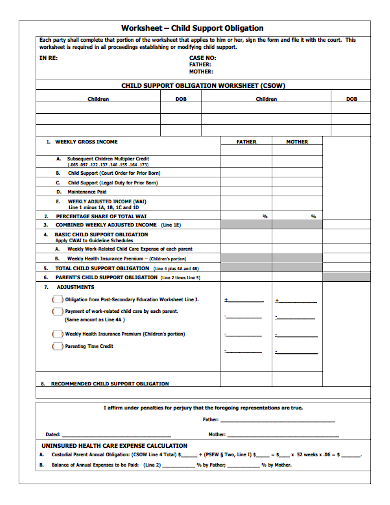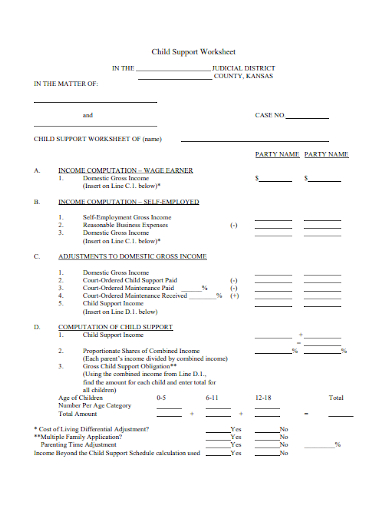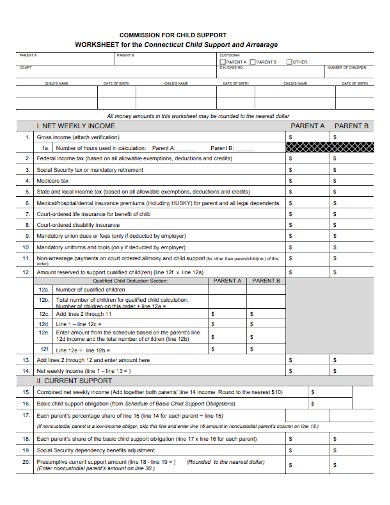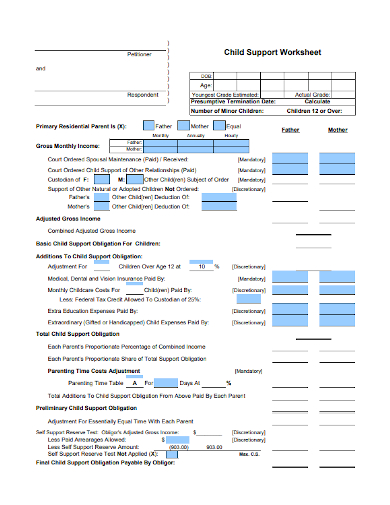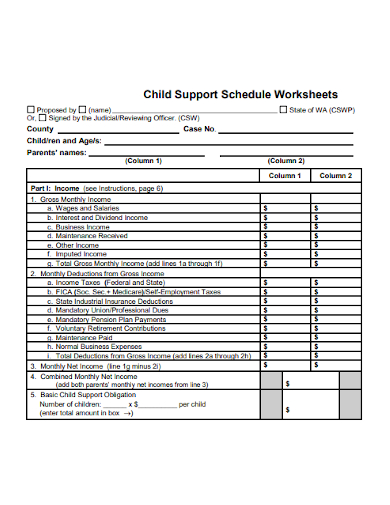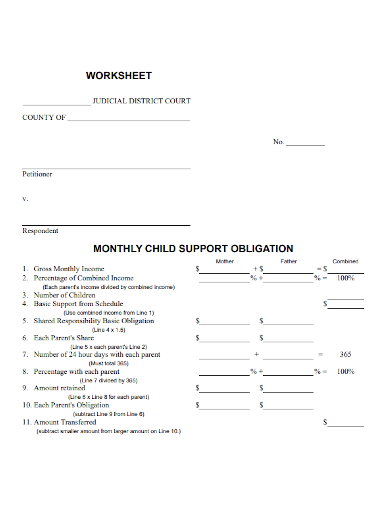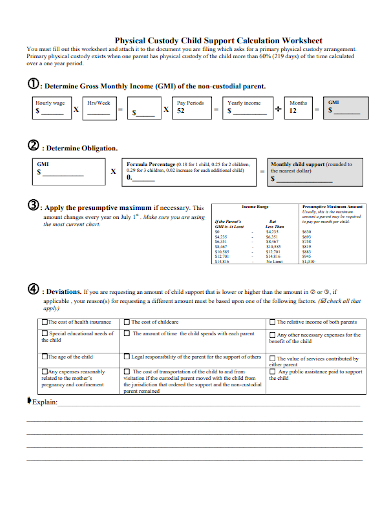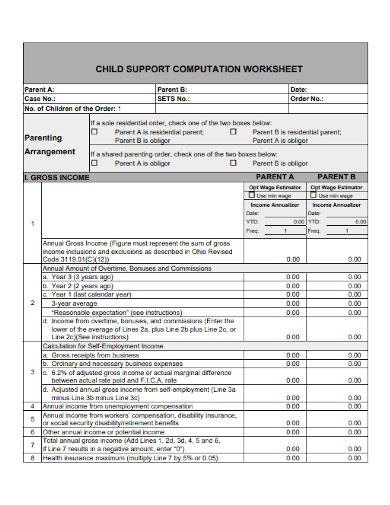Children require financial assistance from their parents, and they are entitled to it under the law. When parents divorce or split, they should strive to agree on a child support sum. If they seek the court to make the decision, the court will apply guidelines to calculate child support payments. Some child support laws are governed by federal law, while others are governed by provincial or territory legislation. The rules that apply are determined by the family’s circumstances.
10+ Child Support Worksheet Samples
Child support is money being paid from one parent to the other to support a child or children financially. The non-custodial parent pays child support to the custodial parent the majority of the time, but this isn’t always the case. The child support you pay or receive, as well as what expenditures it should cover, will vary depending on where you live and the arrangement you reach.
1. Child Support Obligation Worksheet
2. Basic Child Support Worksheet
3. Child Support Guidelines Worksheet
4. Formal Child Support Worksheet
5. Commission for Child Support Worksheet
6. Sample Child Support Worksheet
7. Child Support Schedule Worksheets
8. Standard Child Support Worksheet
9. Monthly Child Support Obligation Worksheet
10. Physical Custody Child Support Calculation Worksheet
11. Child Support Computation Worksheet
Basic Information
For all concerned parties, child support can be complex and complicated. It’s usually better to consult a local family law attorney because the regulations vary from state to state especially if one parent lives in a different state. They will be able to explain and coordinate the efforts of filing and paying child support. There are a few things that all parents should be aware of. To begin with, a custodial parent is one who has main custody of a child for the bulk of the time. On the other hand, defining a non-custodial parent is difficult. It usually refers to a parent who doesn’t have any physical custody of their child but does have legal custody.
While most people connect non-custodial parents with men, this is not always the case, and many moms are also responsible for paying child support. Similarly, a non-custodial parent may be actively involved in the life of their kid, and parents may opt to co-parent. It’s also worth noting that child support is not contingent on the parents’ marital status.
The purpose of child support, regardless of the circumstances, is for the parents to share the financial burden of raising their children. This usually entails the non-custodial parent making regular contributions to help the child meet his or her basic needs.
The amount of child support is determined by the combined income of both parents. Each state has its own set of rules for calculating the compensation. Court-ordered payments are frequently deducted from the wages of the non-custodial parent.
If you owe child support but can’t afford to pay, you should file for a child support modification. Likewise, if you need to apply for government aid, any child support you obtain may affect your eligibility.
FAQs
What is the use of the money paid as child support?
Child support payments are supposed to go toward the care of the children involved. It cannot be used for personal expenses by the custodial parent. This is when things can become perplexing, and disagreements may occur.
What are examples of child’s necessities?
Child support is intended to sustain a child’s living level and ensure that all of his or her basic requirements are met. The funds can be used to cover expenses such as:
- Shelter, which includes the rent or mortgage, as well as the utilities of the child’s principal residence, in order to ensure that they are living in a secure setting.
- Food, clothing, toys, books, and furniture that will be used by the child.
- Medical costs, such as doctor’s appointments, prescriptions, eyeglasses, dental care, and other services necessary to keep a child healthy. One parent may elect to include the child in their health insurance plan.
- Books, materials, clothing, and other related fees such as field trips are all included in school expenses.
- Expenses for extracurricular activities, such as sports, summer camps, and other activities in which the child participates.
It’s vital to remember that child support is for the benefit of your children, whether you’re receiving or paying it. Even if there are obstacles along the way, it may make a big difference in your child’s happiness and well-being if their parents act properly and work together to make sure they have all they need.
Related Posts
FREE 14+ Sample Music Concert Proposal Templates in MS Word | Google Docs | Pages | PDF
FREE 10+ Security Guard Contract Samples in PDF | MS Word
FREE 10+ Assurance Agreement Samples In MS Word | Google Docs | Apple Pages | PDF
FREE 10+ Option to Purchase Agreement Samples in MS Word | Apple Pages | PDF
FREE 26+ Curriculum Form Samples in MS Word | PDF
FREE 20+ Cleaning Service Proposal Samples in PDF | MS Word
FREE 29+ Sample Loan Application Form Templates in MS Word | PDF
FREE 10+ Event Venue Contract Samples in PDF | MS Word | Pages | Google Docs
FREE 10+ SBAR Samples in PDF | DOC
FREE 12+ Music Band Contract Templates in PDF | MS Word
FREE 10+ HVAC Maintenance Contract Samples in PDF | MS Word
FREE 10+ Social Media Marketing Contract Samples in MS Word | PDF
FREE 10+ Wholesale Assignment Contract Samples in PDF
FREE 18+ Financial Proposal Samples in PDF | MS Word | Google Docs | Pages
FREE 10+ Feasibility Study Samples in PDF

